The uniqueness of the Pumi’s herding style as compared to other breeds
The herding style of the Pumi and all the other herding breeds was defined by selection in the course of hundreds of years and environmental factors. In other words, the herding dogs of the world were shaped by their work. The nature of the environment, customs, and the temperament of the domestic animals defined what was expected of which dog and what qualities it should possess. This selection emphasized ability and not looks.
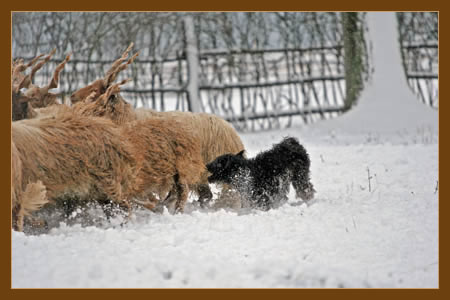
In general
In many countries the livestock was kept semi-wild; specifically, they were driven to the pastures in the spring and only some kind of dog suitable for guarding the herd was turned out with them, who was capable of not abandoning the herd and not chasing them senselessly, at the same time it would keep away any strangers - people and animals. There was no need for constant human supervision; the livestock would graze on the intact pastures from spring to fall. In many places even dogs were rare. There are countries where cattle herds, deer, and other livestock are driven from horseback, but in most places dogs were always used for this purpose.
In the British Isles sheep keeping was unique; huge areas and contiguous pastures were available with large numbers of sheep. When they were spread out, they’d occupy an area of over 2 acres. A smaller-bodied, faster moving herding dog had to be able to gather them completely. To accomplish this, the dog had to run in large arcs, had to be fast and at the same time had to cause the least amount of stress, otherwise the sheep would run and scatter; more sensitive breeds would even perish from the suddenly induced stress.
Grazing the sheep was done in a similar manner in France, Spain and Australia.

Hungary has a unique environmental factor compared to other countries. It was typical that every piece of land was divided and cultivated. Dividing the land into narrow strips is characteristic, each few yards wide strip of land was owned by someone else. These strips were criss-crossed by narrow roads, dykes, flood plains, wooded or shrubby areas.
In many cases the livestock owners didn’t even own pastures, or theirs was too small to sustain all their livestock. Consequently, they had to rent pastures which could be miles away. They had to drive their livestock every day over narrow roads, strips of land, and if possible, had to avoid causing damage to the adjacent properties. Here the dogs didn’t have the opportunity for outruns in wide arcs, because there was no room. Often they had to go ahead between the livestock’s feet to their front to turn or to stop the flock. The dog had to be able to protect a cornfield immediately on the side of the road from the flock, specifically it had to “patrol” - move back and forth between the sheep and the cornfield to prevent the animals from going into the crop. As a result, the sheep got accustomed to the fact that when the dog is close, it’s working. There was a need for a dog which likes to work close and is not afraid of livestock.
We have three such herding breeds: the Puli, the Pumi and the Mudi. All three are capable of performing the work described above; there are only shades of differences between their herding styles, or rather there were regionally different herding dog characteristics in Hungary.
The Puli can be seen most often in the Hortobágy region, whereas the “ancestral home” of the Pumi is in the Transdanubian region of Somogy; the Mudi was mainly favored in the area of the southern plains.
Barking
The Pumi can be easily accused of being a barking breed, but it’s not so. Its barking only emphasizes its control over the livestock, if necessary. The whole flock hears the barking, even if it consists of 2000 animals. For this reason, it’s not desirable for the dog to bark during any action, because this irritates the flock unnecessarily, and it can’t hear a command while barking. However, if it was in a pen, or a sheep or cattle was recalcitrant, the dog could achieve a lot by barking! Owners didn’t like constantly barking dogs in the past as well, and they were culled if they couldn’t get it to stop barking continuously. The Pumi can be trained to bark on command and in many places they utilized this option. When they saw that the dog has difficulties in taking control of a situation, they made it bark if it didn’t do that instinctively. Or else, in some situations they don’t let the dog get close to the stock because it’s very skittish or there are many lambs among them - and there is a chance they’d be trampled in the scramble – they stop the dog at a distance and command it to bark.
This barking is more than enough to make the sheep to go into the desired narrow space without trampling each other. A Pumi with good instincts knew exactly when it had to bark to assist with moving the sheep.
The picture is different with the Border collie: the Collie doesn’t bark. It advances with slow, stalking motion and stares at the stock with “strong” eyes.
It doesn’t go close, but only to the point where the sheep starts to behave as the dog wants it to. If the sheep moves in the wrong direction, it’ll react by moving in the direction. The dog always strives to maintain eye contact. When it senses that the livestock noticed it, it’ll attempt to move the stock with precise movements in the right direction.
It won’t go to the animal’s immediate vicinity, and it’s not a characteristically grippy dog. It achieves with the sheep what it wants with its body size and movement.
Distance keeping, gripping
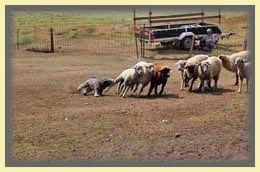
The herding style of the Pumi is herding by charging, friskily hopping, threatening. If it gets into a difficulty, it takes control over the stock by barking. Grips often if barking is not sufficient. Tearing into the sheep or hard biting is not desirable, but tugging on the wool or rather a warning nip – which doesn’t leave a mark on the stock – is permissible; furthermore on most of the sheep farms, recognizing the tougher sheep breeds’ rough behavior – gripping was a requirement. Otherwise a more hot-headed sheep (ewe with a lamb or a tougher ram) won’t take the dog seriously and would charge the dog or even the owner. If the dog ran away and didn’t take control of the situation, it was considered weak. Naturally they didn’t like unjustified gripping, but in tough situations they rather expected of the dog not to be afraid and to resolve the problem with courage.
Dogs were considered good if they gripped when necessary, but didn’t cause injury and avoided such sensitive areas such as the animal’s udders and loins. A good dog knew instinctively where not to cause injuries and still strengthen its position over the stock.
Such instinctive behavior is the reaction to a sheep charging out of the flock. It’s desirable if the dog doesn’t start to fight with the charging individual but avoids it by back and forth movement, thus turning the attacking animal back to the flock. If the dog starts fighting with the stock which is breaking out, instinctively it won’t turn its back to the dog and will draw the dog’s attention to itself; as a result the flock will simply walk away out of the dog’s range of influence.
Another instinctive behavior is when the dog challenges the cattle from the front, until it lowers its head, shakes it with the intent to gore, and the dog will nip the base of the animal’s nose with the speed of lightning. This won’t leave any marks but it’s so painful for the animal that it’ll remember for life who’s the boss!
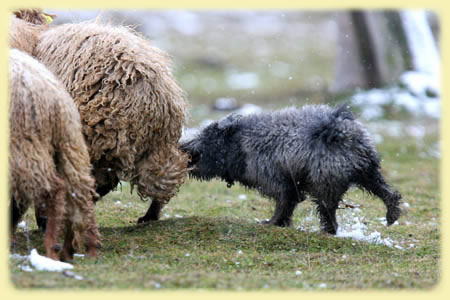
With these tools the Pumi compensated for his relatively small size. The farther it was from the sheep, it was less able to keep the flock under supervision. It loses contact with the flock beyond a few yards. If the dog feels it has to intervene, it heads immediately towards the flock and instinctively, and runs around them at body distance, until they flock again. It grips the stragglers, or barks at them. Its unusually light bone structure and lean musculature enables it to make lightning fast changes of direction, thus it’s almost impossible to knock them down or kick them after nipping. In tight pen work it often happens that the Pumi goes to the head of the flock between the sheep’s feet to resolve a sticky situation. For example, the Australian Kelpie resolves the same issue by running on top of the sheep’s backs, the same way as the recently developed herding dog in Hortobágy, the Sinka. Border Collies don’t like to get in between sheep’s feet.
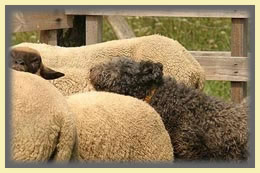
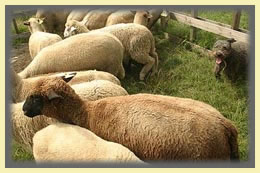
The Collie keeps distance instinctively. This works well with the more sensitive sheep breeds or the slower moving meat sheep found in the British Isles, but not with the more boisterous, tougher, fiercer and faster native Hungarian sheep breeds, grey cattle and swine. They learn quickly that this dog is not dangerous as far as they’re concerned because it doesn’t even come near. The stock towards the center of the flock which can’t see the dog, don’t even notice that there is a quiet stalker somewhere in the vicinity.
This kind of instinctive several yards’ distance keeping can be very unpleasant during driving through a narrow parcel of land, or even during shedding in a tight pen. If the Border Collie resorts to gripping in such tight situations, due to its physical structure it won’t be quick enough to avoid being kicked or knocked down.
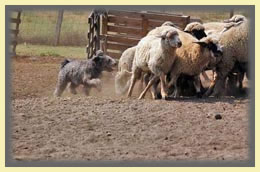 The Pumi completely loses interest in the sheep if we don’t let it near the sheep but only to a few yards from them. The English style training method therefore will destroy the herding drive of the Pumi within minutes. In other words, if the trainer or owner position themselves between the sheep and the Pumi and they constantly drive it away from them - or rather try to make the Pumi to keep distance, the Pumi will lose interest in the whole thing in no time because the very same tools are taken away from it which enabled it throughout its whole life to work instinctively and made it capable of independently resolving complicated tasks!
The Pumi completely loses interest in the sheep if we don’t let it near the sheep but only to a few yards from them. The English style training method therefore will destroy the herding drive of the Pumi within minutes. In other words, if the trainer or owner position themselves between the sheep and the Pumi and they constantly drive it away from them - or rather try to make the Pumi to keep distance, the Pumi will lose interest in the whole thing in no time because the very same tools are taken away from it which enabled it throughout its whole life to work instinctively and made it capable of independently resolving complicated tasks!
Relationship
The Pumi’s relationship is first of all with its owner. It’s said that it’s a “one owner” dog. This means its motivation is mainly the owner with whom the dog is in an adequate subservient-superior relationship, rather than the livestock and work. The Pumi is driven by its desire to fit in and its readiness to act, that is, it’ll work very willingly for the owner if that’ll please him/her. At the same time it’s waiting with expectation for its master’s commands. Its ability to assess the situation and its decision-making ability are excellent, therefore it can solve complicated tasks on its own exceedingly well. It always attempts to make its decisions based on its master’s wishes. It won’t work for just anyone, even if it knows what to do.
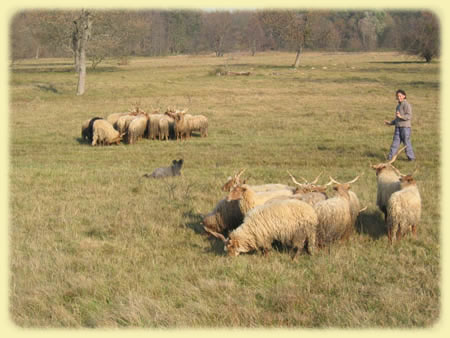
The Pumi can’t be left alone with the sheep all day long out in the pasture because it’ll come back after the owner. A Hungarian owner never liked if the dog wasn’t at hand all the time, because the flock could turn onto the neighbor’s land any moment. If the dog happened not to be nearby, the flock could have caused tremendous damage. Therefore the owner went as far as getting a dog which always stayed by the owner’s feet, or rather was readily available. They didn’t spend time with constant disciplining of the dog. The dog either knew it on its own or it was out of the house! It was a tough selection. For a Pumi not being able to herd is not a punishment. The real punishment for a Pumi is the owner’s wrath, the lack of good relationship with the owner, or constant disciplining, nitpicking commands where it has no independence. The Pumi doesn’t like this. It’s similar to the task of freely following when a German Shepherd can be taught to heel exceedingly well at its owner left side, in such a manner that its head is always in line with its master’s knee. A Pumi will have a tough time learning this, but then free following is an instinctive act for it, and it doesn’t have to be taught to do that. It walks behind the owner in a sweeping “half crescent” motion. It’ll give its life for the owner – if their relationship is good. It reacts sensitively to the owner’s mood swings.
In contrast, the Border Collie is the total opposite of the Pumi. It maintains a very strong contact with the sheep and it's characteristic that it’ll work for anyone who is familiar with the appropriate commands and is capable of giving it directions. It can be left with a flock, because it’s capable of not taking its eyes off the sheep for a whole day. The Border Collie can be disciplined by denying work from it. It’s severe punishment for it if it can’t work. Besides directions, the Border Collie should be rather trained to be able to leave the flock if it doesn’t have to work. It is a “workaholic” in that context. The Pumi will leave the flock when the owner heads home. It only works alone with the flock until it completed all the required tasks. For example, it is capable of bringing the flock home from a pasture several miles away if this is done on a familiar terrain with a familiar flock under familiar circumstances!
Gathering instinct, balancing
Balancing is a concept used by certain herding breeds. This means instinctive behavior. The dog goes instinctively to the opposite side of the flock from the owner and starts to gather and drive it towards the owner. If the flock move away from the owner’s direction, the dog instinctively moves so, that it pushes the flock back in the owner’s direction. It’s balancing. This is so characteristic of the Border Collie and the Kelpie that most dogs will start balancing from the first moment they meet the sheep. If the owner shifts his/her position, the dog instinctively turns the flock towards him/her. According to some professional literature this is a suppressed hunting instinct, where the owner is the leader of the pack who has the right of possession over the herd, and killing in the course of the hunt is his/her duty; the rest of the pack “play to the hand” of the leader. Supposedly the cleaner, more refined variation on this is the instinctive behavior of pushing the flock into the owner’s “hands”.
The Border Collie doesn’t take its eyes off the flock, even if it’s not moving. It doesn’t like to leave the flock. It wants to keep an eye on them as long as possible.
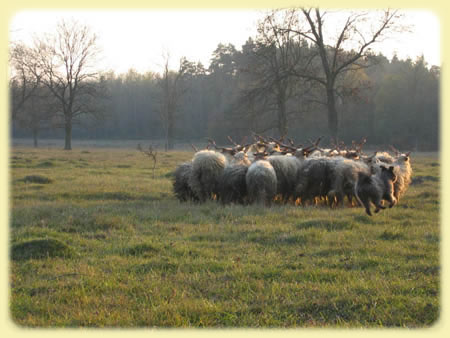
In the Pumi this instinct is not present as strongly, although it’s observable, but in a slightly different form. Not in the manner of gathering and driving to the owner, but in the manner even out ancient definition calls the rounding up instinct. Specifically, the dog instinctively and on its own circles, runs around the flock and puts the individuals which are sticking out, back into the flock. Often this is spectacular because the sheep start to circle around the center, but the flock itself stays together. This is also called holding. That is, the dog doesn’t let the stock escape, it holds them until a different command is issued. While it’s rounding up, it doesn’t matter where the owner is, because it doesn’t work relative to him/her, like the Border Collie. Naturally, it doesn’t do this continuously, but only until the livestock stick together in one bunch and when they’re not attempting to break out and escape any more, the Pumi would leave them. It’s only interested in the livestock while they’re moving. Stationary sheep don’t motivate it as much.
Since this rounding up and balancing instinct is not that strong in the Pumi, it can be easily made to drive, that is, it’s capable of pushing the flock in any direction, independent of the owner.
Suppressed aggression
This term can be readily used in conjunction with the Pumi. This only means that the dog shows signs of aggression and toughness outwardly, it has a decisive, intolerant to any resistance appearance, however it knows exactly when to stop. 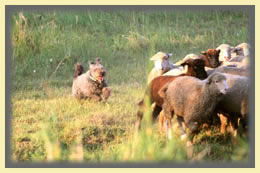 That is, it seems from the outside as if it’d tear its victim apart, but at the same time it allows itself only to apply gentle nips as a hint, because it doesn’t really want to inflict any injuries. The Pumi simply attempts to make the opponent believe that it is stronger. This is strongly present in a Pumi with a healthy instinct: we only have to observe its frightening fighting style of herding while attacking, lunging and hopping.
That is, it seems from the outside as if it’d tear its victim apart, but at the same time it allows itself only to apply gentle nips as a hint, because it doesn’t really want to inflict any injuries. The Pumi simply attempts to make the opponent believe that it is stronger. This is strongly present in a Pumi with a healthy instinct: we only have to observe its frightening fighting style of herding while attacking, lunging and hopping.
In several countries they already integrated the suppressed aggression gauge into the temperament test of herding dogs similar in characteristics which are planned to be bred; if the dog does not appear decisive or demonstrates too much aggression, it gets marked down severely. What does this mean in practice?
For example it means that the dog would grip a 300 pound ram if it doesn’t behave, while it won’t touch a two months old lamb except push it with the nose if it doesn’t keep up with the flock. The dog does the same with an old, lame animal as well; it only pecks it to urge it to move faster so it won’t lag behind. If the dog becomes too rough and starts tearing into the lagging livestock, then the dog is too aggressive and liable to kill a weaker animal – therefore this is not suppressed aggression any more. It can’t be trusted to be in charge of livestock on its own because it can lose self-control and even kill an animal in some cases; it’s not trustworthy. This is undesirable roughness; such dogs were culled a long time ago.
In the Border Collie, any kind of aggression and biting is not permissible, as well as barking.
That’s why the gripping, barking, nipping and hopping Border Collies were selected out from work. Therefore we can’t mention the concept of suppressed aggression in conjunction with them.

To sum it up, we can claim that the Hungarian herding dogs have been subjected to special selection compared to the world’s herding dogs, and accordingly their training is unique – a good herding dog has to be “built up” differently from other foreign herding breeds. Such a training method is described in the section “Training the Pumi”.
Krisztina Menyhárt | Kondacsipkedő Team
Translated by Meir Ben-Dror
453 Dill Road, Landrum, SC 29356 USA
Email: mbendror@ws19ops.com
Phone: +1 864-313-6788
HINT: The page is printer friendly, printable in an economic, easily readable format